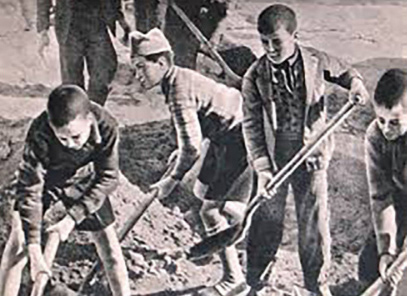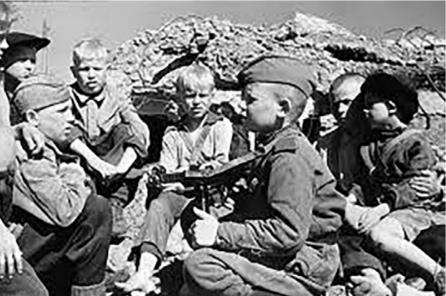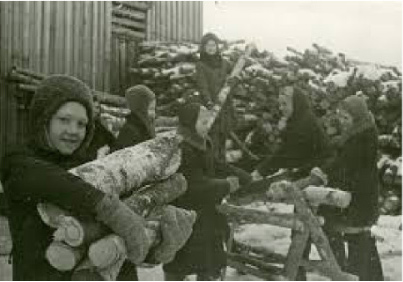This website uses different cookies. We use cookies to personalise content, provide social media features, and analyse traffic to our website. Some cookies are placed by third parties that appear on our pages. You can find more information and options to choose from in our Privacy Policy and Configurations for usage.
Lesson Plan
Anna K. , Russia
13-16 years
45 minutes
Abstract
This lesson gives students an opportunity to see the war through the eyes of children who kept diaries or have written memoirs. Through identification with the authors, students get a sense of the times, and can show empathy. Working in a group, the students will learn to read a historical source, and (through discussion) will get a feel for what life was like for a wartime child, and gain a better understanding of the everyday hardships of wartime.
Overall goal
To learn how the daily lives of children in different countries changed during WWII.
Detailed goals
- To get a sense of the tragedy, and to appreciate the vicissitudes, of the life of an ordinary person during the war. To realise that war affects everyone: rich and poor, adults and children, no matter where they live.
- To acquaint the students with the concepts ‘way of life’ and ‘everyday life in wartime’.
- To compare wartime everyday life in different countries: the USSR (Belarussian SSR, Russian SSR), Poland, Germany.
- To teach the children to search for information in a historical source (using analytical skills, identifying key information, performing critical analysis), and to read a historical source.
Methods used
The Source Method, discussion, case study, analysis and comparison.
Equipment
Handouts (texts from 9 diaries, or memoirs, and questions on them), an OHP (desirable), devices with internet access (students’ mobile phones), map, labels to stick on the screen.Authors of diaries / memoirs
- Anna Nekrasova. Born in 1927 in the village of Petrovskoye,Khomutovsky District, Kursk Region, Soviet Russia.
- Lev Posherstnik. Born in 1924 in Tula, Soviet Russia.
- Valentina Shishlo (neé Danilova). Born into a military family on February 10, 1936 in the village of Belitsa Zhlobin region, Belarusian SSR.
- Zinaida Goryachko. Born on June 11, 1931, and lived in the small village of Vysochany, Liozno district, Vitebsk region, Belarussian SSR.
- Krystyna Markówna. From Przemyśl, Poland.
- Jadwiga O.. Born in 1925, Drohobych district, Lviv Voivodeship, Poland.
- Gerda Altpeter (neé Rappaport). Born in 1926, from Essen, a city in the Ruhr region and the federal state of North Rhine-Westphalia, Germany.
- Ursula Brecht (neé Lindemann). Born 1928, from Cologne, Germany.
- Gertrud Zillikens (née Riediger). Born May 19,1933, in Braunsberg (now Braniewo) in East Prussia, Germany.
Agenda and timings
| Introduction | Group work | Answering the teacher’s questions | Discussion and conclusions |
| 8 minutes | 15 minutes | 10 minutes | 12 minutes |
Introduction
5 minutes:
Introduction by the teacher
The teacher refreshes the students’ knowledge of WWII. She prompts them to remember when WWII began for different countries, and to recall what were the opening hostilities. Using the map, the students examine the movement of the front line, and remind themselves how long the war went on, and when it ended.
The teacher asks: How do you understand the term ‘everyday life’? The teacher listens to the answers and then explains the term using examples of the students’ own lives.
3 minutes:
The teacher explains the task. Depending on the class size, the teacher divides the class into a maximum of 8 groups. Each group is given the diary/memoir of a child who lived during WWII.
Part 1: Group work
15 minutes:
Group work with the diaries/memoirs. The students have to find answers to questions about the child who wrote the diary/memoir. The teacher can show the questions via the OHP. Where they see answers to the questions, the students should make notes on the printouts of the diary/ memoir, by underlining key words or writing them in the margin.
Assignment: Look at the material. Find the child’s place of residence on the interactive map on the screen. Attach a label. Find a description of the locality on the internet. What was the situation on the front line?
Part 2: Answering the teacher’s questions
10 minutes:
Questions (the students should answer in the first person)
- Please introduce yourself (what is your name, how old were you when the war started?)
- Which of you lived in a city? Which of you lived in a village? What country did you live in?
- Who did you live with? What did your parents do? In what conditions did you grow up?
- How did you learn about the beginning of the war?
- What has changed in your life since the beginning of the war?
- What did you do during the war? How did you help your family or your friends?
- What difficulties did you experience with supplies of food?
- What did you manage to retain from peacetime in your daily life?
- Look at the photos of the war years. Choose the one which might be a picture of you (your diary/memoir author). Explain the basis of your choice.
Part 3: Discussion and conclusions
10 minutes:
Discussion (moderated by the teacher).
Questions for discussion:
Option 1
- What differences were there between the children’s everyday lives before and during the war?
- What differences were there between the daily lives in different countries?
- When did the child have to make a difficult choice? Why couldn’t he/she have acted differently?
- Why do children write about terrifying events in such a calm way?
- What impressed you most in the diaries/memoirs and why?
Option 2
- What differences and similarities are there in the situations in which the children found themselves?
- Which child was in the most difficult situation?
- What impressed you most in the diaries/memoirs and why?
2 minutes:
Conclusions. The teacher makes a brief summary of the discussion.
Photos






Other Lesson Materials
The beginning and end of World War II
Remembrance and memorialisation of World War II in different countries
Young people and forced labour during World War II
Border changes resulting from World War II
Consequences of World War II
Video: Clash of Memories